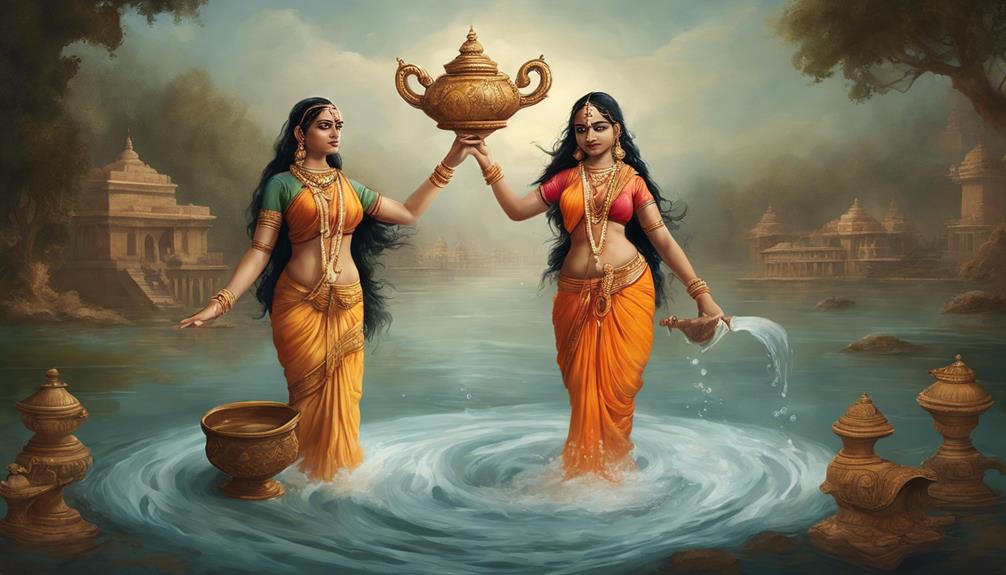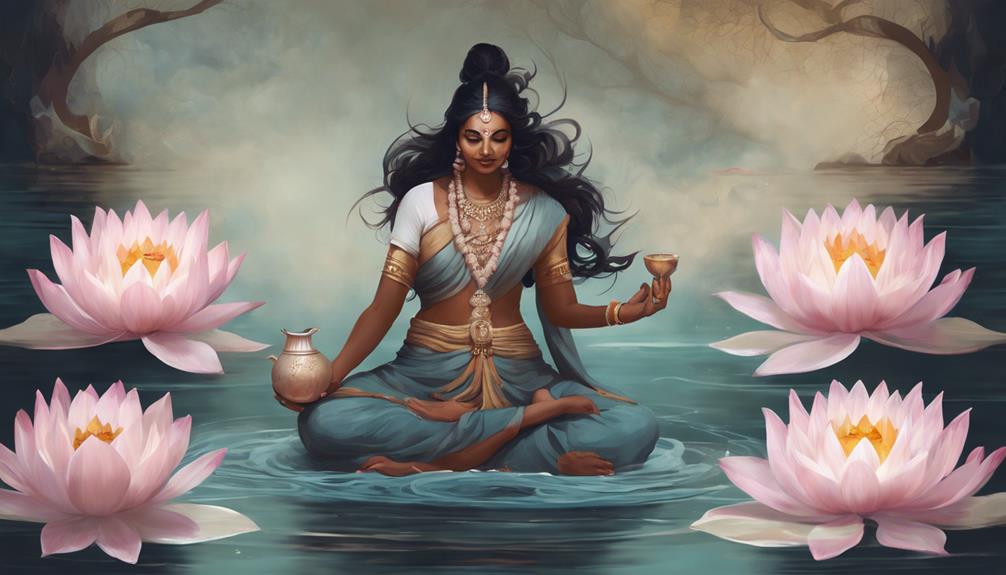In Hinduism, the goddesses Ganga and Yamuna are representations of purification and sustenance, respectively. Ganga symbolizes spiritual cleansing and liberation, while Yamuna embodies growth and prosperity. Through rituals and offerings, devotees worship these goddesses to seek spiritual connection and renewal. Artistic depictions capture their divine essence, with Ganga often shown with a water pot or riding a crocodile, and Yamuna as a youthful maiden holding a water lily. These goddesses hold deep cultural significance and offer a holistic understanding of existence, emphasizing balance between spiritual and material aspects of life.
Their symbolism in Hindu mythology transcends into various aspects of worship and cultural festivals, showcasing their enduring influence on devotees seeking spiritual fulfillment and purity.
Table of Contents
Key Takeaways
- Ganga symbolizes purification, liberation, and spiritual cleansing.
- Yamuna represents fertility, sustenance, and nurturing aspects in Hindu mythology.
- Artistic depictions show Ganga with symbols of purity like water pot and lotus flower.
- Yamuna is often depicted as a youthful maiden holding a water lily.
- Both goddesses embody divine grace, balance spiritual and material aspects, and offer spiritual liberation.
Mythological Origins
In Hindu mythology, the origins of Goddesses Ganga and Yamuna are deeply intertwined with the cosmic fabric of creation and the spiritual significance they hold in the pantheon of deities. These mythical legends depict Ganga as the personification of the sacred Ganges River, revered for its purifying properties and role in Hindu rituals. Yamuna, on the other hand, is associated with the Yamuna River, symbolizing fertility and sustenance in Indian culture.
The cultural significance of these Goddesses is reflected in religious practices where devotees worship them during ceremonies and festivals. Ganga and Yamuna aren't only physical rivers but are also spiritual entities embodying purity and divine grace. The spiritual importance of these Goddesses lies in their ability to cleanse sins and grant spiritual liberation to believers who bathe in their waters or seek their blessings.
Comparatively, while Ganga is often depicted as a fiercely independent Goddess, Yamuna is portrayed as a nurturing and compassionate deity. Despite their distinct characteristics, both Goddesses are revered for their roles in sustaining life and upholding spiritual values in Hinduism.
Divine Attributes
With their divine attributes, Goddesses Ganga and Yamuna embody distinct qualities that symbolize different aspects of spiritual and earthly domains in Hindu mythology. Ganga is revered for her purifying nature, symbolizing purity, cleansing, and liberation. She's believed to wash away sins and bestow spiritual purification upon those who immerse themselves in her waters.
Yamuna, on the other hand, represents nourishment, sustenance, and fertility. Her gentle and nurturing qualities are associated with the fertile lands along her banks, where agriculture thrives. While Ganga's divine qualities are more aligned with spiritual significance and inner purification, Yamuna's attributes lean towards the earthly domain, emphasizing growth, abundance, and prosperity.
Together, these goddesses encapsulate a balance between the spiritual and material worlds, offering devotees a holistic understanding of existence that encompasses both the sacred and the worldly aspects of life.
Symbolism in Art

When exploring the symbolism in art representing Goddesses Ganga and Yamuna in Hinduism, consider the intricate details and sacred symbols used to depict these divine beings.
The artistic representations often carry deep meanings and spiritual significance, reflecting the goddesses' roles and attributes in Hindu mythology.
Artistic Representations of Goddesses
Symbolism in art plays an important role in conveying the essence and attributes of Goddesses such as Ganga and Yamuna in Hinduism. The symbolic depictions of these goddesses in artistic styles reflect their cultural significance and offer various visual interpretations.
In Hindu art, Ganga is often represented as a beautiful woman holding a water pot, riding a crocodile or standing on a lotus flower. These symbols convey her purity, divine grace, and life-giving abilities.
On the other hand, Yamuna is depicted as a youthful maiden holding a water lily, symbolizing fertility, beauty, and auspiciousness. The artistic representations of Ganga and Yamuna serve as visual metaphors, capturing the spiritual essence and significance of these revered goddesses in Hindu mythology.
Sacred Symbols and Meanings
Sacred symbols embedded in the artistic representations of Hindu goddesses like Ganga and Yamuna offer profound insights into the cultural and spiritual significance of these deities.
The sacred waters of the Ganga River symbolize purity, cleansing, and the divine flow of life. In artistic depictions, Ganga is often shown with water flowing from her hair, emphasizing her role as the bestower of life and spiritual purification.
On the other hand, Yamuna, representing the sacred river Yamuna, is associated with love, compassion, and the nurturing aspect of the divine. Her portrayal in art often includes a water pot, symbolizing the nourishing waters of the Yamuna River.
The combination of these symbols in artworks conveys a deep spiritual connection to the sacred waters and the profound significance of these goddesses in Hinduism.
Rituals and Offerings
When exploring the rituals and offerings associated with Goddesses Ganga and Yamuna in Hinduism, you'll find that symbolic offerings hold deep significance in these practices.
The tradition of ritual baths in the sacred waters of the Ganges and Yamuna rivers is a central aspect of worship.
Additionally, presenting sacred flower garlands to these goddesses symbolizes devotion and reverence in Hindu rituals.
Symbolic Offerings Significance
In Hindu rituals and offerings, devotees use a variety of symbolic items to honor Goddesses Ganga and Yamuna, representing purification and sustenance. These offerings hold profound spiritual significance in Hindu practices.
The act of offering water, flowers, incense, and lamps symbolizes a deep connection to the divine feminine energy embodied by Ganga and Yamuna. Water signifies purity and cleansing of the soul, while flowers represent devotion and beauty. Incense is believed to carry prayers to the heavens, fostering spiritual connection, and lamps symbolize the dispelling of darkness with the light of knowledge.
These cultural traditions are deeply rooted in symbolic meanings, emphasizing the importance of ritual practices in invoking the blessings and grace of the goddesses.
Ritual Bath Traditions
To understand the significance of Ritual Bath Traditions associated with Goddesses Ganga and Yamuna in Hinduism, one must explore the ceremonial practices and offerings that mark these sacred rituals. These rituals are deeply rooted in the belief of symbolic cleansing and spiritual rejuvenation.
The sacred rivers Ganga and Yamuna hold immense importance in Hinduism, with ritual baths in their waters considered a form of ritual purification. Devotees believe that immersing oneself in these holy waters during specific auspicious times can cleanse sins and purify the soul.
The act of bathing in these rivers is seen as a way to connect with the divine and seek blessings for health, prosperity, and spiritual growth. The Ritual Bath Traditions symbolize the cyclical nature of life, renewal, and the continuous flow of spiritual energy.
Sacred Flower Garlands
Sacred Flower Garlands play a pivotal role in the ceremonial rituals and offerings dedicated to the Goddesses Ganga and Yamuna in Hinduism, symbolizing reverence and devotion through their intricate adornment. These floral adornments hold deep spiritual significance, representing purity, beauty, and the cycle of life.
The ritual decorations of garlands not only embellish the physical form of the goddesses but also establish a divine connection between the worshippers and the deities. The act of offering these garlands is a way to honor the goddesses and seek their blessings in return.
The fragrant flowers woven into the garlands are believed to please the deities and create an atmosphere of sanctity during worship ceremonies.
Sacred Purification
Symbolizing purity and divine grace, the representations of Goddesses Ganga and Yamuna in Hinduism hold significant roles in the ritual of Sacred Purification. Water purification and spiritual cleansing are essential aspects of Hindu rituals, and the rivers Ganga and Yamuna play crucial roles in these practices.
The Ganga, believed to have descended from the heavens, is considered one of the most sacred rivers in Hinduism. Bathing in the Ganga is believed to cleanse one of sins and lead to spiritual purification. Similarly, the Yamuna river, associated with love and compassion, is also revered for its purifying properties in Hindu rituals.
The ritual of Sacred Purification often involves devotees immersing themselves in the sacred waters of these rivers or using the water for ceremonial baths. The belief in the purifying nature of these waters is deeply ingrained in Hindu traditions, symbolizing the cleansing of the body, mind, and soul. The representations of Goddesses Ganga and Yamuna as embodiments of purity and grace highlight the importance of water purification in spiritual practices within Hinduism.
Temples and Pilgrimages

The pilgrimage sites and temples dedicated to Goddesses Ganga and Yamuna stand as revered destinations for devotees seeking spiritual fulfillment and connection to these sacred deities in Hinduism. These sites hold immense spiritual significance, as they're believed to be imbued with the divine presence of the goddesses themselves. Pilgrims visit these sacred places to partake in devotional practices and sacred rituals that are meant to honor and seek blessings from Goddess Ganga and Yamuna.
Devotees often engage in rituals such as offering prayers, lighting incense, and performing ablutions in the holy waters of these rivers to show reverence and seek purification. The temples situated along the banks of the Ganges and Yamuna rivers serve as focal points for these devotional activities, fostering a sense of connection between the worshippers and the goddesses they revere.
The act of setting off on a pilgrimage to these sacred sites is considered a significant aspect of Hindu religious practice, symbolizing a journey towards spiritual enlightenment and divine grace. The pilgrimage experience allows devotees to deepen their faith, purify their souls, and strengthen their bond with the goddesses Ganga and Yamuna.
Cultural Festivals
Celebrated with vibrant colors and joyous festivities, cultural festivals associated with Goddesses Ganga and Yamuna in Hinduism serve as integral expressions of devotion and community celebration. These festivals are deeply rooted in cultural customs and hold immense spiritual significance for devotees. The worship of rivers Ganga and Yamuna is intertwined with festive celebrations that encompass traditional practices passed down through generations.
During these festivals, devotees gather to pay homage to the goddesses, seeking blessings for purity and prosperity. The rituals performed during these occasions often involve elaborate ceremonies, including offering prayers, lighting lamps, and immersing in the sacred waters of these rivers. The festive atmosphere is filled with music, dance, and traditional performances that add to the joyous spirit of the celebrations.
Through these cultural festivals, devotees not only express their devotion to the goddesses but also strengthen their sense of community and religious identity. The traditions associated with these festivities help preserve the rich heritage of Hinduism and foster a deep connection with the divine feminine energies embodied by Goddesses Ganga and Yamuna.
Influence on Worship

The pivotal cultural festivals associated with Goddesses Ganga and Yamuna in Hinduism deeply influence the way devotees express their worship and spiritual connections. Worship practices related to these goddesses often involve rituals centered around water, such as taking a dip in the Ganges River to cleanse oneself spiritually or offering flowers and lamps to honor Yamuna. These practices not only hold religious significance but also reflect the cultural importance of these goddesses in Hindu traditions.
Spiritual devotion plays a pivotal role in the worship of Goddesses Ganga and Yamuna. Devotees often express their reverence through acts of service, like volunteering at river clean-up drives or participating in religious processions that celebrate the divine presence of these goddesses. These acts of devotion are deeply intertwined with religious practices that have been passed down through generations, highlighting the enduring significance of Ganga and Yamuna in Hindu worship. The influence of these goddesses on worship extends beyond mere rituals, shaping the spiritual experiences and connections of devotees in profound ways.
Modern Interpretations
Reflecting evolving societal values, contemporary interpretations of the Goddesses Ganga and Yamuna in Hinduism emphasize their relevance in environmental conservation and gender equality. In modern perspectives, these deities are seen as symbols of purity and guardians of natural resources, particularly water bodies. The worship of Ganga and Yamuna has extended beyond traditional rituals to incorporate advocacy for clean water initiatives and sustainable environmental practices. Their depiction now serves as a reminder of the importance of preserving the environment and the interconnectedness of all living beings.
Furthermore, modern interpretations highlight the cultural significance of Ganga and Yamuna in promoting gender equality. These goddesses are revered for their strength, resilience, and nurturing qualities, challenging traditional gender roles and stereotypes. By celebrating Ganga and Yamuna as powerful divine figures, Hinduism fosters a more inclusive and equitable society where women are respected for their leadership and contributions. Overall, the modern interpretations of Ganga and Yamuna showcase their enduring relevance in addressing contemporary issues and promoting values of environmental stewardship and gender empowerment.
Frequently Asked Questions
What Are Some Common Misconceptions About the Goddesses Ganga and Yamuna in Hinduism?
Misconceptions about Ganga and Yamuna in Hinduism often stem from oversimplification. Their symbolism goes beyond physical rivers; they represent purity, life, and spirituality. Understanding their cultural significance enriches ritual practices and deepens spiritual connections.
Are There Any Specific Regions in India Where the Worship of Ganga and Yamuna Is More Prominent?
In India, river worship of Ganga and Yamuna holds immense cultural significance. Pilgrimage sites like Haridwar and Varanasi are key centers for their reverence. Folk traditions portray these goddesses as sources of spiritual purity.
How Do the Representations of Ganga and Yamuna Differ in Other Religions or Belief Systems?
When examining cross-cultural comparisons of goddesses like Ganga and Yamuna, iconography variations are apparent. Symbolism exploration reveals mythological parallels, showcasing how these divine figures resonate differently across different religions and belief systems.
Are There Any Famous Stories or Legends That Involve Ganga and Yamuna Interacting With Other Hindu Deities?
In Hindu mythology, divine rivalries and mythological connections often intertwine Ganga and Yamuna with other deities. Sacred encounters reveal symbolic meanings, enriching the tales of these goddesses' interactions with prominent figures in Hindu lore.
How Have the Depictions of Ganga and Yamuna in Art Evolved Over Time in Hinduism?
Over time, the depictions of Ganga and Yamuna in Hindu art have evolved, reflecting the evolution of symbolism and cultural influences. Their representations have shifted to encompass broader meanings and interpretations, resonating with changing societal values.
Conclusion
To sum up, the goddesses Ganga and Yamuna hold significant roles in Hindu mythology, representing purity, fertility, and divine blessings. Their presence in art, rituals, and sacred sites is a reflection of their enduring influence in Hindu culture.
By delving into their mythological origins and symbolic representations, one can gain a deeper understanding of their impact on worship and cultural practices, both in ancient times and in modern interpretations.